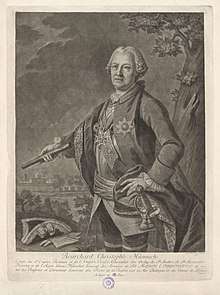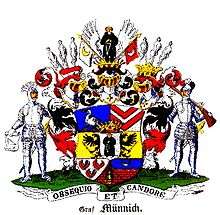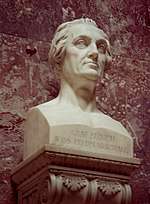Burkhard Christoph von Münnich
Burkhard Christoph Graf[2] von Münnich (Христофо́р Анто́нович Миних, tr. Khristófor Antónovich Minikh; 19 May [O.S. 9] 1683 – 27 October [O.S. 16] 1767) was a German general who became a field marshal and political figure in the Russian Empire. He was the major Russian Army reformer and founder of several elite military formations during the reign of Anna of Russia. As a statesman, he is regarded as the founder of Russian Philhellenism. Münnich also was a hereditary engineer and a specialist in hydrotechnology. He had the grade of count of the Holy Roman Empire of the German Nation.
Burkhard Christoph von Münnich | |
|---|---|
 Count Burkhard Christoph von Münnich. | |
| Born | 19 May [O.S. 9] 1683 Neuenhuntorf, Berne, Duchy of Oldenburg, Holy Roman Empire |
| Died | 27 October [O.S. 16] 1767 (aged 84) Dorpat, Dorpat County, Governorate of Livonia, Russian Empire (present-day Tartu, Tartu County, Estonia) |
| Buried | Private estate |
| Allegiance | |
| Service/ | French Army Army of Hesse Army of Saxony Russian Imperial Army |
| Years of service | 1700–1762 |
| Rank | Field marshal |
| Commands held | Russian Imperial Army |
| Battles/wars | War of the Spanish Succession War of the Polish Succession Russo-Ottoman War |

Early career
Münnich was born at Neuenhuntorf in the Grand Duchy of Oldenburg in the military family of Anton Günther Mönnich (since 1688 von Münnich, an east-Frisian nobility). Beside the knowledge of the native Low German language he also learned the Latin and French languages. He entered the French service at 17. Thence he transferred successively to the armies of Hesse-Darmstadt and of Saxony where he earned the rank of a colonel and later Major General.[3]
In 1721, he was invited by the Russian ambassador in Warsaw Grigoriy Dolgorukov for engineering projects of the newly acquired northern territories. Around that time his father has died. Upon arrival to Russia he presented Peter I plans for the fortification of Kronstadt fortress, which pleasantly surprised the Russian emperor, and the Annenkrone fortification in Vyborg. He was promoted to the Lieutenant General in 1722. Among his first undertakings was the completion of the costly Ladoga Canal, which had been under construction for more than a decade. For his engineering and military-engineering achievements he was promoted to the rank of the General-in-Chief in 1726 by Catherine I, and awarded the Order of Saint Alexander Nevsky. In 1727, Münnich was appointed the Governor of Saint Petersburg city while the Imperial court was temporarily transferred to Moscow by Peter II. From 1728 to 1734 he was a General-Governor of Ingria, Karelia, and Finland as well as was awarded the title of a count. During his governorship Münnich improved the local ports, reinforced the newly established Peter and Paul Fortress (1703), and was thinking of building a bridge towards Stockholm.
Russian army reformer
Upon the coronation of Anna of Russia (1730), he was instructed to prepare the city for the return of Imperial court. After successfully accomplishing that Münnich was promoted to a General-Fieldmarshal, was appointed to the position of president of Russian War Collegiate in 1732 as well as given an order to re-organize the Russian army. Münnich became a founder of the Leib-Guard Cavalry Regiment, the Izmaylovsky Regiment, and the Shlyakhetskiy Cadet Corps which was destined to supply the future generations of officers. [3]
Münnich also reformed numerous other military formations as well as the War Collegiate itself. He established a new formation for the Russian army at that time, the Corps which consisted of 12 regiments Cuirassier Cavalry as well as the first Hussar regiments. Münnich revised the table of ranks and evened the salary of the Russian officers with the invited foreign military specialists. He was the first to introduce the sapper regiments to the Russian army as well as founded the Engineer School for Officers. During his administration some 50 other fortresses were erected which substantially improved the well-being of the Russian Armed Forces at that time. Due to the Andrey Osterman affairs, he was released of his duties.
Ottoman campaign of 1734-1739
In 1734, by the reference of Ernst Johann von Biron he was sent to take the city of Danzig (Gdańsk) and after a prolonged siege and evasion of Stanisław Leszczyński was heavily reproached. However, after that in 1733, the Russian Empire was able to install Augustus III of Poland as the King of Poland (ratified in 1736).
In 1736, as the Commander of the Russian army he headed the Turkish campaigns besieging the important ports of Azak and Özi. On 21 May 1735 he stormed and sacked Or Qapı penetrating into the Crimea peninsula. Münnich destroyed the important Tatar cities of Kezlev, Aqmescit, and Bakhchisaray. He was forced out of the peninsula due to poor logistics and battle fatigue of his formations, while another General, Count Peter von Lacy, took Azak earning himself a rank of the General field marshall. Münnich refused to resume the campaign the very next year, but he returned to the lower Dnieper steppes in 1737, and on 2 July took the fortress of Özi with the help of the Russian artillery. During the sack of Özi, he manually raised the regimental banner of the Izmailovsky Regiment on one of the towers of fortress after a successful attack. The siege of Özi was also later mentioned in the humorous stories about Baron Munchausen, based on the adventures of the page to Duke Anthony Ulrich of Brunswick, Hieronymus von Münchhausen. Due to the heavy losses, the campaign was paused again while conducting negotiations in Nemirov (Podolie) without much result. In 1739, Münnich won the Battle of Stavuchany, took Khotyn two days later, and established himself firmly in Moldavia. His victory in this campaign was later mentioned in one of the Lomonosov's odes, considered to be the first poem of Russian literature. Threatening to burn down the capital of Moldavia, the city of Iași, he forced the Moldavian boyars to sign the annexation of Moldavia. After the Ottoman war he was awarded the Order of St. Andrew and the Golden Weapon for Courage. Due to military losses of the Habsburg monarchy and worsening of the relationship with the Swedish Hats, the Russian Empire had to sign the Treaty of Niš by which it had to return the newly acquired Nogai steppes while keeping the fortress of Azak.
Downfall
Marshal Münnich now began to take an active part in political affairs, the particular tone of which was given by his rivalry with Biron, duke of Courland, whom Münnich had arrested in 1740. Münnich's activity was brought to a close in 1741 by the Elizabeth of Russia; he was arrested on his way to the border, and condemned to death. Brought out for execution, and withdrawn from the scaffold, he was later sent to Pelym, Siberia, where he remained for several years, until the accession of Peter III brought about his release in 1762. [3]
Catherine II, who soon displaced Peter, employed the old field marshal as director-general of the Baltic ports. Münnich died four years later in Tartu and was buried at his estate nearby.
Legacy

Catherine the Great will say of him " If Münnich is not one of the children of Russia, he is one of the fathers ". Frederick the Great professes great admiration for his exploits and calls him "Prince Eugene of the Muscovites". Voltaire wrote for his part: It was Prince Eugene of the Muscovites; he had the virtues and vices of the great generals: skilful, enterprising, happy; but proud, superb, ambitious, and sometimes too despotic, and sacrificing the lives of his soldiers for his reputation. Franz Lacy, Keith, Löwendal, and other skilful generals, were training in his school .
According to Hermann von Manstein, his aide-de-camp: The Count of Münnich is a real contrast of good and bad qualities. Polite, rude, human, carried away, in turn, nothing is easier for him than winning the hearts of those who deal with him. But suddenly, an instant later, he treats them so harshly that they are forced to hate him, so to speak. In certain conditions, we saw him generous, in others of a sordid greed. He is the man of the world who has the highest soul and yet we have seen him do mean things. Pride is a dominant vice. Constantly devoured by an excessive ambition, he sacrificed everything to the world to satisfy it. One of the best engineers in Europe, he was also one of the greatest captains of his century. Often reckless in his businesses, he has always ignored what the impossible is. With a tall and imposing stature, and a robust and vigorous temperament, he seems to have been born general.
Ernst Gideon von Laudon and Franz Lacy did their apprenticeship under his orders in front of Otchakov and Khotin.
Burckhardt de Münnich is buried in his land of Lunia in Livonia [4]. Despite his role as builder of modern Russia, his tomb was desecrated and partly destroyed by the Soviets.
The Imperial Russia 37th Dragoons Regiment used to bear his name.[3]
Heritage
- Christine Lucretia von Witzleben (1685–1727), his wife.
- Barbara Juliana, Baroness von Krüdener was his great granddaughter.
- Count Johann Ernst Munnich (Sergei Khristoforovich Minikh) (1707–1788), his son, Russian statesman, diplomat, writer, studied jurisprudence, languages, and philosophy.
Further reading
- (in Russian) Burkhard Christoph von Münnich. (1874) Notes of Field Marshal Count Münnich (Записки фельдмаршала графа Миниха) at Runivers.ru in DjVu and PDF formats
References
- Carl Arvid von Klingspor (1882). Baltisches Wappenbuch. Stockholm. p. 181. ISBN 978-0-543-98710-5. Retrieved 11 April 2019.
- Regarding personal names: Until 1919, Graf was a title, translated as Count, not a first or middle name. The female form is Gräfin. In Germany since 1919, it forms part of family names.
- Chisholm 1911.
- Literary archives of Europe, or, Mixtures of literature, history and philosophy , {{p. | 403} }
- Attribution
